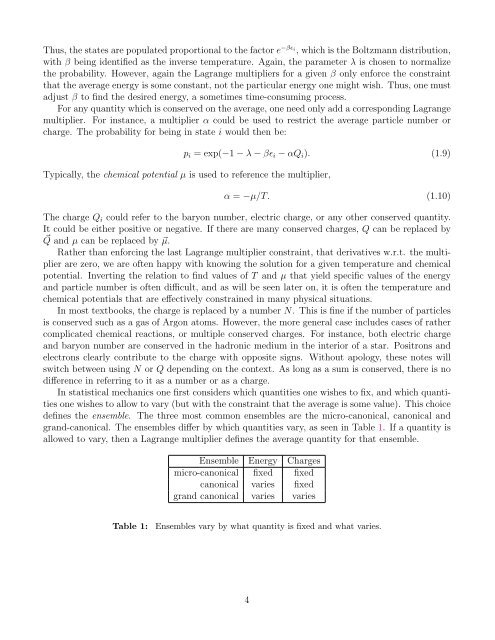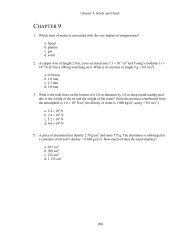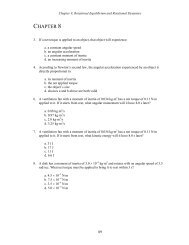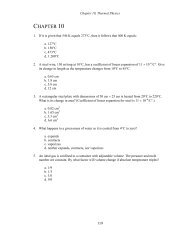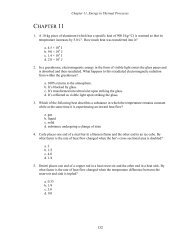lecture notes on statistical mechanics - Scott Pratt - Michigan State ...
lecture notes on statistical mechanics - Scott Pratt - Michigan State ...
lecture notes on statistical mechanics - Scott Pratt - Michigan State ...
You also want an ePaper? Increase the reach of your titles
YUMPU automatically turns print PDFs into web optimized ePapers that Google loves.
Thus, the states are populated proporti<strong>on</strong>al to the factor e −βϵ i, which is the Boltzmann distributi<strong>on</strong>,with β being identified as the inverse temperature. Again, the parameter λ is chosen to normalizethe probability. However, again the Lagrange multipliers for a given β <strong>on</strong>ly enforce the c<strong>on</strong>straintthat the average energy is some c<strong>on</strong>stant, not the particular energy <strong>on</strong>e might wish. Thus, <strong>on</strong>e mustadjust β to find the desired energy, a sometimes time-c<strong>on</strong>suming process.For any quantity which is c<strong>on</strong>served <strong>on</strong> the average, <strong>on</strong>e need <strong>on</strong>ly add a corresp<strong>on</strong>ding Lagrangemultiplier. For instance, a multiplier α could be used to restrict the average particle number orcharge. The probability for being in state i would then be:p i = exp(−1 − λ − βϵ i − αQ i ). (1.9)Typically, the chemical potential µ is used to reference the multiplier,α = −µ/T. (1.10)The charge Q i could refer to the bary<strong>on</strong> number, electric charge, or any other c<strong>on</strong>served quantity.It could be either positive or negative. If there are many c<strong>on</strong>served charges, Q can be replaced by⃗Q and µ can be replaced by ⃗µ.Rather than enforcing the last Lagrange multiplier c<strong>on</strong>straint, that derivatives w.r.t. the multiplierare zero, we are often happy with knowing the soluti<strong>on</strong> for a given temperature and chemicalpotential. Inverting the relati<strong>on</strong> to find values of T and µ that yield specific values of the energyand particle number is often difficult, and as will be seen later <strong>on</strong>, it is often the temperature andchemical potentials that are effectively c<strong>on</strong>strained in many physical situati<strong>on</strong>s.In most textbooks, the charge is replaced by a number N. This is fine if the number of particlesis c<strong>on</strong>served such as a gas of Arg<strong>on</strong> atoms. However, the more general case includes cases of rathercomplicated chemical reacti<strong>on</strong>s, or multiple c<strong>on</strong>served charges. For instance, both electric chargeand bary<strong>on</strong> number are c<strong>on</strong>served in the hadr<strong>on</strong>ic medium in the interior of a star. Positr<strong>on</strong>s andelectr<strong>on</strong>s clearly c<strong>on</strong>tribute to the charge with opposite signs. Without apology, these <str<strong>on</strong>g>notes</str<strong>on</strong>g> willswitch between using N or Q depending <strong>on</strong> the c<strong>on</strong>text. As l<strong>on</strong>g as a sum is c<strong>on</strong>served, there is nodifference in referring to it as a number or as a charge.In <strong>statistical</strong> <strong>mechanics</strong> <strong>on</strong>e first c<strong>on</strong>siders which quantities <strong>on</strong>e wishes to fix, and which quantities<strong>on</strong>e wishes to allow to vary (but with the c<strong>on</strong>straint that the average is some value). This choicedefines the ensemble. The three most comm<strong>on</strong> ensembles are the micro-can<strong>on</strong>ical, can<strong>on</strong>ical andgrand-can<strong>on</strong>ical. The ensembles differ by which quantities vary, as seen in Table 1. If a quantity isallowed to vary, then a Lagrange multiplier defines the average quantity for that ensemble.Ensemble Energy Chargesmicro-can<strong>on</strong>ical fixed fixedcan<strong>on</strong>ical varies fixedgrand can<strong>on</strong>ical varies variesTable 1:Ensembles vary by what quantity is fixed and what varies.4


